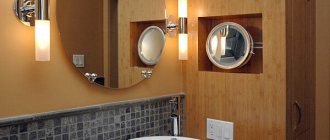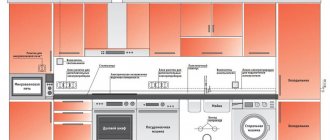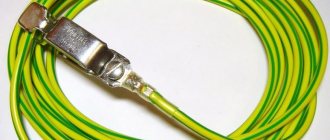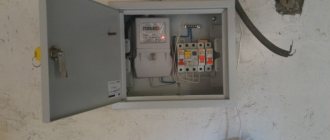Agree that a socket in general is not the most important decoration of a room, and therefore you should not focus on it and place it in a prominent place. Of course, the location of the outlet for the air conditioner does not greatly affect the overall interior of the room, but it should be carefully considered so as not to damage the wall in the future and not to use extension cords again.
We will tell you where to install air conditioning outlets. We will suggest the best and safest places to place a power point. The article also provides recommendations for masking sockets and cords from air conditioning equipment.
Preparing to install an air conditioner
Before you begin installing an air conditioner outlet, you need to consider various options for connecting the cooling system:
- the connection point is connected directly to the junction box. In this situation, they do without a socket and plug. But with this connection method, it should be taken into account that the electrical wiring used must withstand the load during the simultaneous operation of all household devices connected to it. The distribution panel is additionally equipped with a system that controls automatic shutdown in case of overload;
- If an air conditioning device is installed during general repair work, a closed structure is most often used during installation. A special channel is installed in the wall. It houses the cable. One end is connected to the distribution panel, and the other is secured to the outlet terminal. At the final stage, the channel is sealed. At the same time, the interior of the room does not deteriorate. The wiring is not influenced by external negative factors;
- Installation of the socket under the air conditioner can be done in an open way. This method is used if the repairs have already been completed and residents do not want to further damage the wall. One of the ends of the wiring is connected to the junction box. A socket is connected to the other end. The cable is located on the surface of the wall covering. It is placed in a decorative box.
Connecting the system
The key to long-term safe operation of a split system is its correct connection to the electrical network. When installing the electrical network, you should proceed from the rated power of the air conditioner. This indicator is indicated in the technical passport. The electrical line for a split system must be designed for the maximum power indicator that is observed during active operation of the equipment. The power of a non-industrial unit will vary between 800–1800 W. It all depends on the dimensions of the refrigerated room.
Based on these data, the optimal load will be 3–10 A. You will need a standard plug socket for an air conditioner with a rated load power of 16 A.
An exception to the rule is split systems designed for cooling large rooms. A 16-amp outlet will not fit these air conditioners. It simply will not withstand the load of the equipment itself.
Is it possible to connect an air conditioner to a regular outlet?
For household networks, the total power consumption of one household electrical appliance should not exceed 1386 W; if the characteristics of the air conditioner are greater than this indicator, you need a direct connection to the electrical distribution panel, and not to a regular outlet.
When choosing a connection to a socket or panel, you need to consider the following factors:
- Total peak load on the power line. All connected devices are taken into account.
- Possibility of changing the wiring diagram. This is done during repairs.
- Availability of automatic overload protection.
- Air conditioner design. For split systems, the outdoor unit is connected directly to the electrical panel, while the indoor unit can be connected via an outlet.
For industrial models with high power, it is necessary to connect directly to the distribution board without an outlet; a separate cable is laid.
Location
Let's consider the option of connecting an air conditioner, when it is possible to install an outlet near the split system itself, i.e. in the ceiling area. This is either laying wires in the wall, or laying them in a cable channel.
Height
The location of the air conditioner power point in height will obey the following rules:
- using an outlet located a short distance from the ceiling will be convenient and safe (there is no interfering furniture or other interior items nearby, no high humidity, etc.);
- the socket for the air conditioner will not be visible, and the connection itself will be hidden.
This will provide greater ease of use and fits well with aesthetics.
Socket installation
There are two ways to make an air conditioner power point under the ceiling:
- by gating the walls, laying wires in them and installing the socket in the installation box;
- by installing the power cable into the cable channel and installing the same socket there.
Cable channels are safe and easy to install, but they will be clearly visible on the wall. This option for connecting to the air conditioner network can be called aesthetically pleasing. However, wall gating is not always permissible, for example, in some multi-storey apartments, and exactly this method will be more expensive and labor-intensive.
Installation procedure
The most correct solution for connecting an air conditioner to a 220V network is to use a separate power line. This is especially true if you are installing a split system with increased power and performance. Such a line can be protected automatically. With this approach, you can make any cable installation option that is convenient or acceptable for you.
The socket itself is installed in the lifting box on spacer legs (the standard version of the old model), or using a screw connection. It is first connected to the wires. The final installation ends with the installation of the frame and front panel.
In the case of using cable channels, the socket is directly installed in the channel socket, specially designated for installation of electrical installation products.
How to hide a split system outlet?
The air conditioner can be connected to the power supply in such a way that it is completely invisible when looking at it. To do this, the food point is carefully hidden or decorated. In the latter case, this connection option may look like this:
- the power point is hidden in the furniture located nearby, while an inconspicuous cutout is made in the furniture itself, covered with decor;
- in a three-dimensional picture on the wall under the ceiling;
- in aesthetic open shelves, where interior and decorative items can also be installed;
- in the form of a small beautiful cabinet with a door;
- in the form of an aesthetically designed plasterboard block;
- a flat socket is used, but this will still remain a noticeable option;
- other options to suit your taste.
The food point can be designed to match the interior design style and in the same color schemes. It can turn out very original.
Options for connecting the air conditioner to the network
The supply of power for the air conditioner involves two options: a two-wire conventional wire with a phase and a neutral, as well as a three-phase wire, which also includes a ground loop. We recommend that you install the outlet and wires with a ground loop. This is especially true when it comes to high-performance climate control equipment.
Where to place the outlet for the air conditioner
Where should the outlet for the air conditioner be located? There is no strictly regulated standard that regulates its location and the number of connection points to the electrical network in a particular room. The choice of a specific solution is carried out taking into account the following factors:
- room design features;
- where furniture and household appliances are located;
- cross-sectional thickness of electrical wiring;
- power of the air conditioners used.
The distance from the outlet point of the electrical network to the ceiling generally does not exceed 30 cm. The height of the air conditioner outlet depends on the installation location of the indoor unit of the air conditioning system. It is usually mounted close to the ceiling surface. Consequently, the socket is placed next to it. Otherwise, the power cord will dangle, negatively affecting the interior of the room.
When installing sockets, the following recommendations must be observed:
- the distance between the ceiling covering and the nearest edge of the outlet should not be less than 15 cm;
- the distance from the ceiling to the connection point is 30 cm;
- When placing the indoor air conditioner unit in the corner of the room, it is not installed close to the adjacent wall. There should be a space of 20-25 cm between them;
- when the electrical outlet is located at the bottom of the wall covering, the distance between the floor surface and the bottom edge of the outlet is 10 cm. If it is placed lower, when carrying out wet cleaning, you can inadvertently pour water into the connector and damage it;
- the connection point should be located so that it is not blocked by furniture and household appliances;
- If you plan to use an existing outlet, you should check the cross-section of the network cable. It is calculated for a certain device power.
Conclusions and useful video on the topic
Since installing an air conditioner and sockets for it takes a lot of time and effort, the issues of its power supply must be taken as seriously as possible. Before installation, you should take the advice of electricians and designers.
Some recommendations for installing sockets in an apartment are given in the video below:
If possible, you should design the location of an individual outlet and lay a separate power line to ensure uninterrupted operation of the climate control equipment. This can be done both at the stage of major renovation of the premises, and during the installation of an air conditioner in an already renovated room.
Tell us where and how you placed the electrical outlet for the air conditioner in your apartment/office/house. Share the nuances of the location known only to you. Please leave comments, ask questions, post photos in the block form below.
What kind of socket is needed for an air conditioner?
The main parameter for choosing an outlet for an air conditioner is the rated load when connected.
It is recommended to buy a model with a power reserve of at least 10%. Rated voltage 220 V, 16 A. According to the installation method, models can be external, overhead or hidden. The first ones are mounted on the wall surface. They are rarely used if it is not possible to make grooves. Overheads are similar in design, but are designed to connect to wiring coming out of the wall. Can be used as temporary or when it is impossible to form a recess for hidden installation.
Hidden - the most common models. Most of the body is located in a wall niche, the front part protrudes slightly flush. Installation is more complicated than the two described above, but these models have a better design and fit into the interior of an office or apartment.
Choosing a location
Although many people think that there are certain criteria regarding where the socket for a household air conditioner should be located, their location and quantity have absolutely no meaning. Each case involves consideration of questions about the number of electrical appliances and their power, as well as the interior and localization of furniture.
You can install further, but in this case the wire will greatly spoil the aesthetics of the interior. There may not be enough wire length to connect, and then you will have to solve the problem with the help of an extension cord. The length of the cord from the internal air conditioner module is no more than 1 m, so be guided by this parameter. Tips from experts on the rules for locating an outlet for a household air conditioner:
- the ideal distance from the ceiling is 15–30 cm;
- when the module is localized in the central area of the wall, the distance to the nearest wall from the electrical unit should be at least 20 cm;
- if the outlet is planned to be located at the bottom of the wall, then the distance from it to the floor should be at least 10 cm.
The electrical unit for the air conditioner should be freely accessible; furniture and equipment should not be placed near it.
Placement of sockets in the apartment
Requirements for the parameters of the air conditioner network cable
When connecting the air conditioning system to an outlet, you need to take into account the length of the power cord; According to the requirements, it must easily, without tension, reach the power point. It is also worth taking into account the following characteristics:
- Current strength.
- Number of cores
- Section.
- Number of phases.
- Remoteness of the shield.
Electrical wiring made of copper is suitable. Wires with a single-phase connection are recommended. As for the cross-section diameter, its optimal size is 1.5-2.5 millimeters.
Which cable to choose for the kitchen
Next, you need to calculate the cross-section of the common supply wire of the electrical panel and the outgoing wiring to each pantograph. Follow the rules here:
for device loads up to 3.5 kW - copper cable VVGng-Ls 3*2.5mm2
for device loads up to 5.5 kW - copper cable VVGng-Ls 3*4mm2
with a total load of all devices up to 10 kW - copper cable VVGng-Ls 3*6mm2
with a total load of all devices up to 15 kW - copper cable VVGng-Ls 3*10mm2
Why there should be a brand VVGnG-Ls is discussed in detail in the article below:
Even if you have a house with an old grounding system (without a third protective conductor), still do the wiring with a 3-core cable. This will save you in the future from additional costs for reconstruction and replacement of wires.
As a last resort, the third wire will be a backup for zero or phase, in case of a possible break or other damage.
Installation of an air conditioner socket
Having decided where the connection point should be and choosing a model, you can begin installing the outlet for the air conditioner. First, make sure that the power supply is off. For this you need an indicator. The wire cross-section is at least 2 mm. Do not use aluminum wiring; at high power it heats up; do not directly connect to metal elements of electrical circuits. This will lead to oxidation of the contacts. Use copper electrical wires. For wooden walls, only overhead or external models are allowed.
The actual height of the outlet must comply with accepted standards. You need to correctly measure the distance from the floor, ceiling and windows. Use the center as a reference point, not the edges of the outline. When grooved, the depth and width should be 1-2 mm larger than the cable dimensions.
For the work you need a wall chaser, a hammer drill, an attachment for forming a niche in the wall, electrical tape, and heat-shrink tape. When processing concrete or brick surfaces there will be a lot of dust; it is recommended to cover the furniture with film or temporarily remove it from the installation area.
Installation procedure
The installation procedure for the air conditioner socket contains the following:
- Make grooves and a hole.
- Install the wiring.
- Strip the ends of the wires by 0.5-1 cm.
- For hidden models, loosen the fixing screws in the wall mounting hole; for surface-mounted and external models, remove the back cover.
- Secure the cleaned wires (phase, neutral, ground) to the appropriate terminals.
- Check the connection is secure.
- Install the housing into the wall and secure it.
By the way, we recommend a useful article about house plants that you should definitely grow at home to purify the air.
Use an indicator screwdriver to check for electrical continuity. The housing must be securely attached to the wall; even with possible sudden jerks of the plug, it remains in place.
Installing a socket for an air conditioner with your own hands
If you decide to install an air conditioner socket with your own hands, before connecting to the network you need to connect the internal and external units of the split system. To do this, perform the steps in the given order:
- Remove the outer panel.
- Remove the cable clamp.
- Install the cable into the hole located on the rear surface of the cooler.
- Strip and tighten the ends of the cable wire into the terminals.
- Use the clamp to secure the wire.
- Install the decorative cover.
The unit located outside receives electricity from the unit installed indoors and connected to the distribution box.
When you have to lay a separate line for the air conditioner, you need to remember several important recommendations:
- the distance between adjacent wires is at least 3 mm;
- The wire can be laid in a vertical or horizontal plane;
- connections are made using bolts or terminals.
Split system connection options
Connecting an outlet intended for a split system to a common network can occur in several ways.
- The first connection method is through the distributor of the room in which the air conditioner will be located. In this case, you will not need to use the socket and plug of the device. The connection method is feasible if the general wiring of a certain apartment can withstand the power of all devices that will be connected to it at the same time. Make sure all pins are securely connected, do not come loose, and are well protected. Terminal blocks can be used to connect the cable. The air conditioner is very rarely connected directly to the mains. Usually a plug with a cord is used.
- The hidden connection method is used when installing a split system at the time of a major overhaul. In such cases, using a hammer drill, grooves are punched into the wall from the side less visible relative to the device, into which the wiring is hidden. This cable is connected to the air conditioner outlet. The method is optimal based on its aesthetics and safety. To connect to the network, a hidden installation is used.
- The open method is used at the moment when the air conditioner is installed after completion of repair work. One end of the wiring is connected to the distributor, the other - to the socket. The cable runs along the wall. To prevent it from spoiling the view too much, you can use a decorative cable channel. Nests are usually of the overhead type.
- Many people think about whether they need an outlet for an air conditioner if there are already enough of them in the room. If you want to connect to an outlet that powers low-power equipment and is located far from the air conditioner, the problem can be solved using a cable. You will need to place a socket where it will be convenient to connect the air conditioner, and stretch a cable from it to the main power supply point. This option is feasible provided that the main node is powered from a network that can withstand a high rated load, otherwise the risk of overload and burning of the wiring increases.
Air conditioner grounding
Grounding the air conditioner is an integral part for the safe installation of the electrical network. This is an artificially created contact between the ground and the electrical installation. The point is to reduce the voltage to eliminate the risk to people and animals.
Electrical current takes the path of least resistance, so the grounding system is below other sources in the electrical circuit.
Despite this, failure to follow the rules can lead to dire consequences. There are two important points:
- Do not pull out the plug while the device is operating. First, you need to turn off the air conditioner, and then, carefully holding the plug, smoothly pull the cord out of the outlet.
- Contact of the grounding wire is prohibited with the lightning rod, water supply and gas pipelines.
Do not confuse grounding with grounding.
If grounding is intended to reduce the voltage to a safe level, then grounding turns off the system in the event of an emergency - for example, in the event of a breakdown of the housing. Manufacturers indicate the mandatory presence of grounding in the device passport, so do not neglect the recommendations of professionals.
If you suspect a breakdown in the electrical network, grounding or socket, you should call a technician.
Correct installation of the outlet will ensure reliable and safe operation of the air conditioner for many years. It is important to take into account the nuances and do the work efficiently.
Types of switches
Switches are manually operated switching devices and are used to turn lights on and off. They have different designs and functions, which led to their division into types.
Switches with built-in motion sensor
Switches with motion sensors are mainly used on staircases and when creating street lighting networks. They are quite easy to use: in order to start using these devices, you just need to install and configure them according to the instructions.
The appearance of switches equipped with a motion sensor may differ, but functionally they are very similar
The basis of switches with a motion sensor are electronic components that constantly analyze changes occurring in the level of illumination of an object (apartment, street or house), as well as any movements in the area where the sensor operates.
The principle of operation of switches with a motion sensor
The operation of a motion sensor switch is based on constant scanning of infrared (IR) radiation covered by the field of view of the sensor (sensor), which is usually made of pyroelectric materials. Basically, such switches have a wide viewing angle and are installed on ceilings. In addition to monitoring the presence of living objects, they have the ability to change the intensity of lighting, and can also be used in various internal security systems.
The switch sensor turns on the lighting when moving objects appear in its coverage areaRemote switches
A remote switch is a set consisting of a compact control unit and a remote control (there may be several of them). The device itself is quite similar in appearance to a simple flat-type switch. A distinctive feature of the remote switch is its ease of installation, since in order to install it, you do not need to carry out preparatory work (trenching or drilling walls), or conduct hidden wiring. You just need to choose a convenient place, take a few screws and double-sided tape and attach the device.
Installation of a remote switch does not require complex electrical work
Operating principle of remote switches
The operation of remote sensors is based on the receive/transmit principle. The user presses the power button on the remote control, thereby creating a radio signal, which then receives a relay that closes or opens, depending on the command sent from the remote control, the phase circuit connected to the light source. Depending on the state of the circuit, the light turns on and off. The coverage area directly depends on the design features of the living space, as well as on the materials that were used during construction. In general, the coverage area of remote sensors is from 20 to 25 m. The transmitters are powered using regular 12 V batteries (usually enough for 5 years).
Video: remote switch
Touch switches
Small and compact devices, structurally made from several touch panels, which simplifies their use. In order to use this type of switch, you just need to touch its screen once.
Touch switches operate with a light touch of a finger
These switches include:
- touchpad (an element that responds to touch and initiates sending a command for subsequent processing);
- control chip (engaged in processing and converting commands);
- switching part (provides power switching).
Through the use of electronic components, you can remotely control lighting devices and connect additional elements: motion, temperature and light sensors.
Touch switches can be equipped with a remote control
Video: touch switch
Before purchasing a switch of one type or another, you should familiarize yourself with the selection criteria, which will be described below.
Living room
At the door
For the location of switches and sockets at the living room door, the same rules apply as in the kitchen: height 75-90 cm, free access for all family members of different heights.
Photo: kvadrim.ru
An outlet is also needed in the entrance area: for a vacuum cleaner or a heater. On average, the height from the floor should be 30 cm, from the door opening - 10 cm.
In the TV zone
A TV is a must-have item for many in the living room. The TV area needs several sockets. The average height of the location is 130 cm, then they will not be visible behind the equipment. You will need 2 electrical outlets and one outlet each for TV and Internet.
Design: Studio NW-Interior
In the sofa area
When planning outlets in the living room, you need to take into account the location of floor lamps, electrical appliances, as well as additional outlets for a laptop and telephone. The average height is from 30 cm.
Often, when planning outlets in living rooms, appliances such as air conditioners, electric fireplaces, humidifiers and game consoles are forgotten. Consider the appliances you have and those you plan to purchase, and based on this, plan the number of outlets.
At the desktop
Often the living room is also a work area. In this case, you will need more sockets. Provide 2-3 pieces in the place where the desktop will be. It’s more convenient to place them above the table so as not to have to crawl under it every time to turn it on/off, but not everyone likes this solution aesthetically. If you have a desktop computer, you can put sockets at the bottom - it is unlikely that you will constantly turn it on and off.
Design: ItalProject
What not to do
Let us emphasize what basic requirements exist when installing an air conditioning device in a room:
- do not place the device next to large furniture - it will interfere with the correct movement of air flow
- negative decision - the location of the air conditioner is connected with the localization plane of a large number of people
- cold air should not be directed directly at a person - this will provoke the occurrence of colds
- You should not install the device above constantly operating heating appliances - it will wear out, which will negatively affect its service life
- The device also cannot be mounted in places with high-frequency operating devices - the commands and settings of the processor responsible for the operation of the cooling system may be lost
- do not install the device in areas with a difficult air circulation system, otherwise the required air temperature in the room will not be maintained: pushing off from an artificial obstacle, the air will return to the air conditioner, the automation of which will decide that the necessary thermal conditions have been achieved and will simply turn off the device
- The indoor unit of the climate control unit should be installed as level as possible so that the condensate flows through the tube into the street and does not drip onto the floor of the apartment
- if there is a canopy over the external structure, you should make sure that it is not an obstacle to the removal of exhaust air from the system
In general, there are three basic schemes for introducing an air conditioner into the electrical network. Which one to choose should be decided situationally, based on the living conditions of a particular room.
Please note that installing the device yourself and connecting it to power may negatively affect the functioning of the entire system. Sometimes it is better to spend a small amount and invite a specialist to at least consult with him about the installation process.
Guided by the recommendations given in the article, you can carry out competent installation of a climate control system in a residential area, correctly connect it to the electrical network, and also extend its service life for many years.











